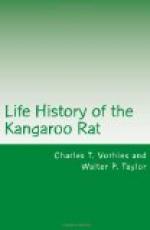UNITED STATES DEPARTMENT OF AGRICULTURE
Bulletin No. 1091
Also Technical Bulletin No. 1 of the
Agricultural Experiment Station, University of Arizona
Washington, D. C. Professional paper September, 1922
Life history of the kangaroo rat,
Dipodomys spectabilis spectabilis Merriam.
By Charles T. Vorhies, Entomologist,
Agricultural Experiment Station,
University of Arizona; and Walter P. Taylor,
Assistant Biologist,
Bureau of Biological Survey, U. S. Department of Agriculture.
CONTENTS.
Page
Importance of rodent groups 1 Investigational methods 2 Identification 3 Description 5 General characters 5 Color 6 Oil gland 6 Measurements and weights 7 Occurrence 7 General distribution 7 Habitat 7 Habits 9 Evidence of presence 9 Mounds 9 Runways and tracks 10 Signals 11 Voice 12 Daily and seasonal activity 12 Pugnacity and sociability 13 Sense developments 14 Movements and attitudes 15 Storing habits 15 Breeding habits 16 Food and storage 18 Burrow systems, or dens 28 Commensals and enemies 33 Commensals 33 Natural checks 34 Parasites 35 Abundance 36 Economic considerations 36 Control 37 Summary 38 Bibliography 40
Note.—This bulletin, a joint contribution of the Bureau of Biological Survey and the Arizona Agricultural Experiment Station, contains a summary of the results of investigations of the relation of a subspecies of kangaroo rat to the carrying capacity of the open ranges, being one phase of a general study of the life histories of rodent groups as they affect agriculture, forestry, and grazing.
IMPORTANCE OF RODENT GROUPS.
As the serious character of the depredations by harmful rodents is recognized, State, Federal, and private expenditures for their control increase year by year. These depredations include not only the attacks by introduced rats and mice on food materials stored in granaries, warehouses, commercial establishments, docks, and private houses, but also, particularly in the Western States, the ravages of several groups




